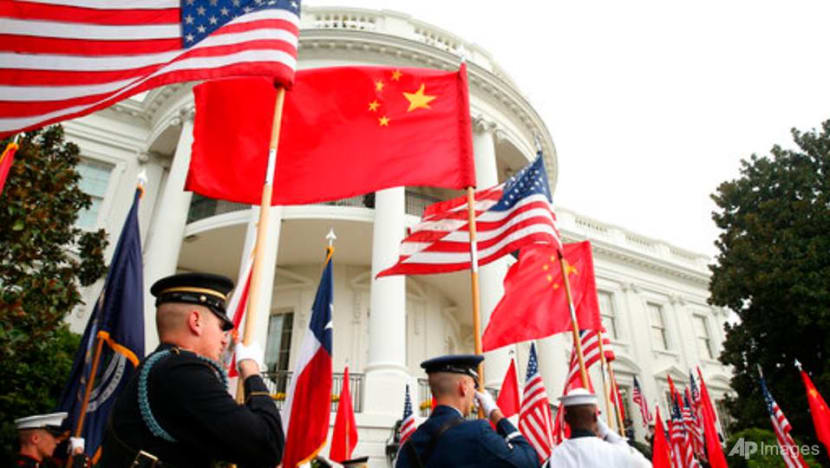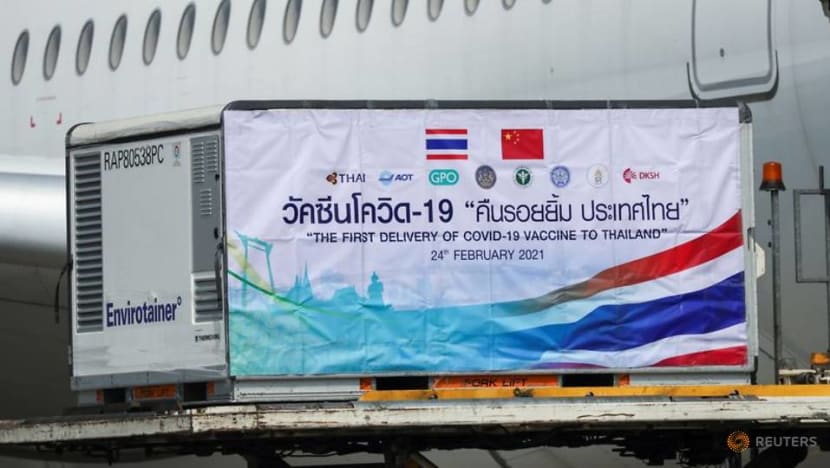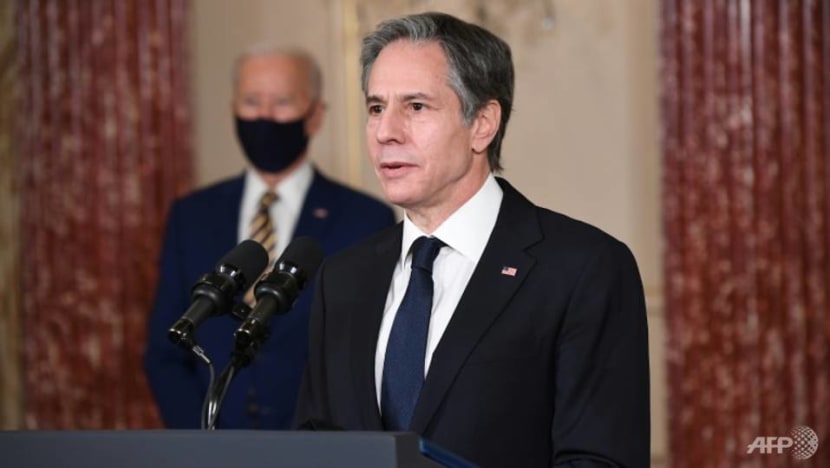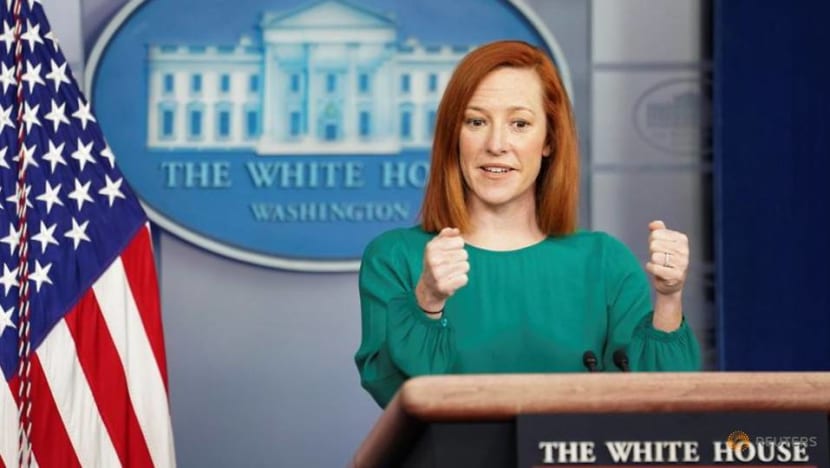commentary Commentary
Commentary: First high-level US-China meetings seem destined to flounder
The best possible outcome of the bilateral meeting later this week is an identification of topics of mutual interest for further negotiation, says Christian Le Miere.

(Photo: AP)
LONDON: China and the US have agreed to have their first high-level diplomatic meeting later this week, but don’t expect too much from it.
The US is in no mood to compromise, at least not yet.
That much has been made apparent by two different factors: A flurry of meetings in Asia preceding the Sino-US meeting in Anchorage that underlined Washington’s desire to present a united front with its allies, and the tough rhetoric emanating out of Washington regarding the meeting.
READ: Commentary: US must confront China’s assertive, expansionist Asia strategy
REASSURING ALLIES
The gathering involving US Secretary of State Antony Blinken, US National Security Advisor Jake Sullivan with Chinese Politburo member Yang Jiechi and Foreign Minister Wang Yi will take place in Alaska from Mar 18 to 19.
But it follows a host of meetings the US has held with key Asian powers in order to reassure and bolster its relationships in the region as it seeks to counter China’s rise.
On Mar 12, President Joe Biden dialled into the first ever, albeit virtual, heads of government meeting for the Quad, the informal grouping of four Indo-Pacific states of Australia, India, Japan and the US that all share a concern about China’s rise and behaviour.
READ: Commentary: China’s divide-and-conquer strategy isn’t fooling anyone anymore
The rapid development of the Quad over the past year after more than a decade of being moribund is the clearest example of how the US sees itself in a competitive relationship with China now, bringing together disparate allies and friends to forge a loose alliance of democratic states.
In many ways, this perception was catalysed by the Trump administration but is equally shared by the Biden administration as it forges its own strategy toward China.
In the recent Quad meeting, the four states agreed, among other things, to forge a combined vaccination response aiming for the delivery of 1 billion doses of COVID-19 vaccines in the Indo-Pacific region.

The vaccination pledge comes as China has expanded its own export of vaccines to 25 countries, largely in Asia, the Middle East and Africa, with a total of half a billion doses pledged to 45 countries worldwide.
Despite concerns that the Chinese vaccine is less effective than Western counterparts, Beijing’s “vaccine diplomacy” has been largely a success – even after Brazil chose the Indian-manufactured vaccine over the one made in China – helping it style the “Health Silk Road” as a renewed aspect of the Belt and Road Initiative.
The US needed to respond, and has chosen the Quad to do so, with India stepping up to produce and export vaccines to large parts of the developing world, including Afghanistan, Bangladesh, Cambodia, Myanmar and Nepal.
Similarly, before Secretary of State Blinken flies into Anchorage for the Sino-US meeting, he will visit Japan and South Korea as part of his inaugural overseas trip.
READ: Commentary: The US’ greatest asset in East Asia may be Japan
The location of the Secretary of State’s first overseas trip is symbolic: In 2009, Hillary Clinton flew first to Japan, Indonesia and South Korea, in a clear nod to the Obama administration’s later focus on a “pivot” to Asia.
In 2001, Colin Powell toured the Middle East on his first trip, clearly prefacing the Bush administration’s near-total focus on the region.
Blinken’s Asia tour likewise underlines the importance the Biden administration places on the Indo-Pacific and its most urgent foreign policy goals.
Alongside Secretary of Defense Lloyd Austin, Blinken will hold “2+2” meetings with Japanese and South Korean counterparts, which will aim to reassure allies of the US’ commitment and resolve just as these Asian states fret about China’s assertive activities.

The Biden administration thinks their predecessors did great harm to relationships in the region and are looking to repair them. The quick signature last week of the US-Korean Special Measures Agreement on new cost-sharing for US deployments to the peninsula underlined Washington’s desire to rebuild tarnished ties and move on to building a joint response to China.
READ: Commentary: They already have jet bombers and super missiles. Will Chinese fighter jets be more powerful than America’s soon?
RHETORIC AND MESSAGING
Not only has Washington been keen to reassure allies, the Biden administration has also been eager to utilise deeply uncompromising language when it comes to China.
In recent weeks, Chinese diplomats and spokespeople have underlined the need for a “reset” in relations. US representatives, meanwhile, have stressed they now view the relationship as being one of “extreme competition”.
Blinken stated this week that he will raise the issue of the Uighurs in Xinjiang during the meeting, which is unlikely to endear him to his visitors.
The result has been a divergent set of messages prior to the meeting, suggesting little room for agreement.
READ: Commentary: US-China relations - age of engagement comes to a close
While such messaging can be a strategy to bolster the US’ negotiating position, tellingly, the unspoken messages from the US on the logistical arrangements for the meeting have been inflexible.
While the last meeting between Chinese and US diplomats (between top diplomat Yang Jiechi and Secretary of State Mike Pompeo) was held in Hawaii, and notwithstanding the fact that Blinken would be visiting China’s neighbours the day before, the US insisted this meeting be held on US soil.
The inclusion of Jake Sullivan is also a sign that the Biden administration is seeking to demonstrate a cohesive, robust and whole-of-government approach to China.
BIDEN STRATEGY
The importance of these two factors – ally reassurance and uncompromising messaging – was laid bare by White House spokesperson Jen Psaki, who said: “It was important to us that this administration’s first meeting with Chinese officials be held on American soil, and occur after we have met and consulted closely with partners and allies in both Asia and Europe.”

The Biden administration’s diplomatic strategy for dealing with China hinges on being able to negotiate firmly with China from a position of strength, built on a united alliance and a competitive economy and society.
After making such a big deal about listening to the concerns of allies and repairing the relationships, the US is unlikely to forego their interests just to appease China.
Moreover, backed by a newfound bipartisan hawkishness toward China in Washington, and with the passage of the US$1.9 trillion COVID-19 relief bill that the administration expects will provide a strong economic background in the future, the US is unlikely to seek out compromise or show any weakness in negotiation at the present time.
That’s not to say that the meeting will be a total bust. Both sides will be eager to demonstrate their willingness to negotiate and to refute allegations of intransigence.
READ: Commentary: It’s engagement not containment of China that Joe Biden will focus on
READ: Commentary: Parts of Asia will miss Donald Trump’s tough China policy
Both have signalled a desire to collaborate on areas of mutual interest such as climate change, global health and other transnational areas. Some vague commitments to further negotiations in these areas should be expected.
But the overall tenor of the relationship currently has been defined by tension and wariness. The US has signalled little desire to withdraw tariffs placed by the Trump administration or slow down freedom of navigation operations in the Taiwan Strait or South China Sea.
China too is not diverting from its antagonistic policies in its near seas or over issues such as Hong Kong, where just this week a roadmap for electoral reform was passed that led to US criticism.
All this suggests the meeting is likely to be a tense discussion with little room for agreement, and the best possible outcome is an identification of topics of mutual interest to be targeted for further negotiation.
SIGN UP: For CNA’s Commentary weekly newsletter to explore issues beyond the headlines
Christian Le Miere is a foreign policy adviser and the founder and managing director of Arcipel, a strategic advisory firm based in London.












